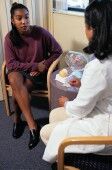Chlamydia Testing Often Not Done at Office Visits
Although young women often see their obstetrician-gynecologists or primary care physicians for pelvic exams, Pap smears and urinalyses, chlamydia testing is often not performed at the same time, according to study findings published in the May issue of Obstetrics & Gynecology.

FRIDAY, May 2 (HealthDay News) -- Although young women often see their obstetrician-gynecologists or primary care physicians for pelvic exams, Pap smears and urinalyses, chlamydia testing is often not performed at the same time, according to study findings published in the May issue of Obstetrics & Gynecology.
Karen Hoover, M.D., and Guoyu Tao, Ph.D., from the U.S. Centers for Disease Control and Prevention in Atlanta, analyzed data from the 2005 National Ambulatory Medical Care Survey to estimate the prevalence of chlamydia screening among women aged 15 to 25 during visits to obstetrician-gynecologists and primary care physicians.
The researchers found that there were 6.3 million visits to obstetrician-gynecologists and 20.9 million visits to primary care physicians. Obstetrician-gynecologists conducted 68.8 percent of visits with pelvic examinations and 71.1 percent of visits with Pap tests, while primary care physicians conducted 77.5 percent of visits with urinalyses. However, obstetrician-gynecologists did not perform chlamydia testing at 82.1 percent of visits with pelvic examinations and 77.3 percent of visits with Pap tests, and primary care physicians did not perform testing at 99.1 percent of visits with urinalyses, the report indicates.
"There are many missed opportunities for chlamydia testing of young women in ambulatory care visits -- during pelvic examinations, Pap tests and urinalyses," Hoover and Tao conclude.
AbstractFull Text (subscription or payment may be required)
Copyright © 2008 ScoutNews, LLC. All rights reserved.